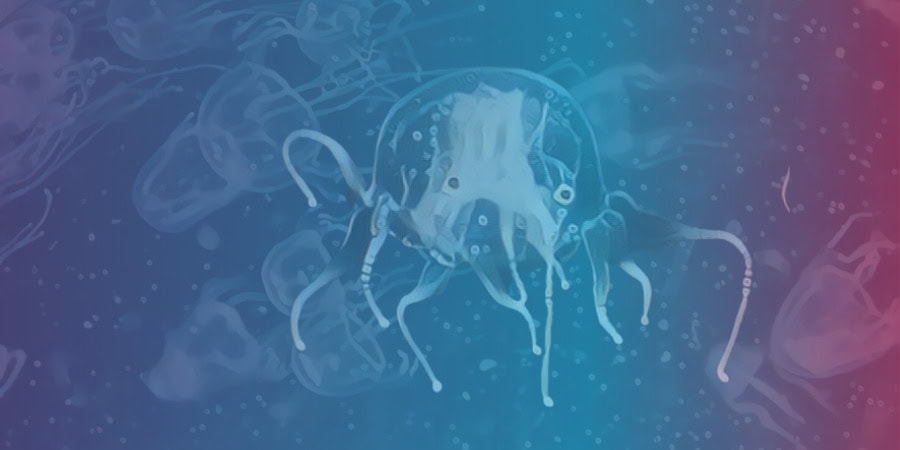Key Takeaways
- New Box Jellyfish Species: Scientists at the Hong Kong Baptist University have found a previously unknown species of box jellyfish, Tripedalia maipoensis, in a local shrimp pond. This marks the first discovery of a box jellyfish in Chinese waters.
- Unique Characteristics: The newly discovered box jellyfish species is transparent with a colorless body and possesses 12 tentacles that end in paddle-like structures. It has 24 eyes arranged in clusters of six around its cubic bell, distinguishing it from other jellyfish species.
- Enhanced Mobility: The paddle-like structures on the tentacles enable this species to navigate through water at a faster pace compared to most other jellyfish. Its bell and tentacles are connected by a flat base resembling a boat paddle, setting it apart from common jellyfish.
- Feeding Habits: The species likely feeds on copepods, small crustaceans found abundantly in the shrimp pond samples. Although it is uncertain whether T. maipoensis can sting humans, the researchers believe it may be venomous enough to paralyze tiny shrimp.
- Importance of Research and Conservation: This discovery highlights the significance of marine biodiversity in the Hong Kong region and Chinese coastal waters. It also emphasizes the need for further research and conservation efforts to protect these unique creatures and their habitats in the face of environmental disruptions and growing interest in jellyfish.
Scientists at the Hong Kong Baptist University have recently uncovered a completely new species of box jellyfish, a type of Cnidarian, in a local shrimp pond.
This fascinating discovery in the Mai Po Nature Reserve marks the first-ever box jelly discovered in Chinese waters.
These tiny, cube-shaped jellyfish, now named Tripedalia maipoensis, are almost completely transparent with a colorless body or bell, and are equipped with 12 tentacles ending in small, paddle-like structures.
This unique feature allows these small creatures to navigate water at a faster pace compared to most other jellyfish species.
The distinguishing characteristics of this new species also include 24 eyes arranged in clusters of six around its cubic bell.
Their tentacles and bell are connected with a flat base resembling a boat paddle, distinguishing them from other common jellyfish.
The species is likely to feed on small crustaceans, known as copepods, which were found in abundance in the shrimp pond samples.
While it is still unclear whether T. maipoensis can sting humans, the research team led by Qiu Jianwen, a professor in the Department of Biology, noted that the animal might be venomous enough to paralyze tiny shrimp called Artemia.
This finding represents a significant addition to marine biodiversity in the region, showing the potential for more marine life discoveries in Hong Kong and Chinese coastal waters.
Jellyfish: The Underappreciated Marine Marvels
Jellyfish, known by many names around the world, are often a source of fear due to their venomous stings.
They are particularly adaptable creatures, surviving in a wide variety of environments ranging from the North to the South Pole, from the surface to the deep seas, and even in freshwater.
However, their fascinating biology and ability to withstand a variety of conditions have often been overlooked, with studies usually focused on larger and more charismatic megafauna.
These marine creatures are as captivating as they are feared. They exhibit an array of colors, shapes, and sizes and have even proven to be biologically immortal.
Despite their longevity and adaptability, which has seen them outlive 99 percent of all other species, they’ve largely been ignored in academic and amateur study of natural history for centuries.
Scientists at the Hong Kong Baptist University have recently uncovered a completely new species of box jellyfish, a type of Cnidarian, in a local shrimp pond.

The Jellyfish Renaissance
Recently, however, the tide seems to be turning for these marine organisms. Increasing human activity and environmental disruptions, such as overfishing, pollution, and climate change, are leading to larger jellyfish blooms.
This sudden surge in their population is causing significant disturbances across several industries, including aquaculture, power plants, shipping, and tourism, leading to increased attention on these creatures.
Simultaneously, there’s a growing commercial interest in jellyfish.
They’re harvested for a variety of uses, ranging from food products like snacks and Asian cuisine delicacies to non-food products like super-growth fertilizers for rice, super-absorbent paper towels, sanitary products, and even as thickeners for caramel candies.
Final Thoughts
As our understanding of these mysterious creatures deepens, so does our appreciation for their resilience and adaptability.
The discovery of the new box jellyfish species in Hong Kong is a testament to the untapped potential of marine biodiversity in the region.
It also sheds light on the need for further research and conservation efforts to protect these unique creatures and the ecosystems they inhabit.








